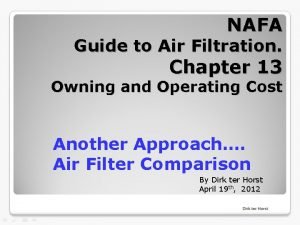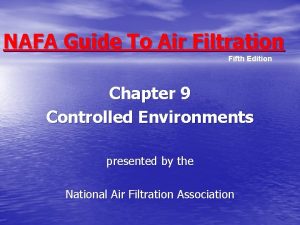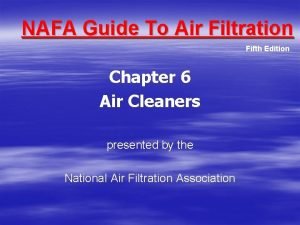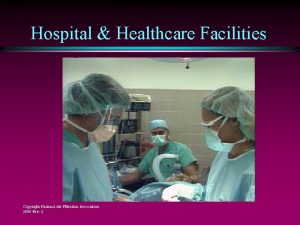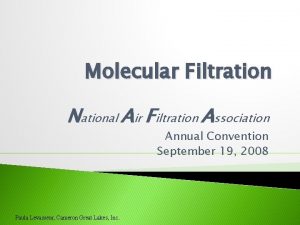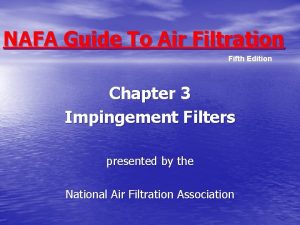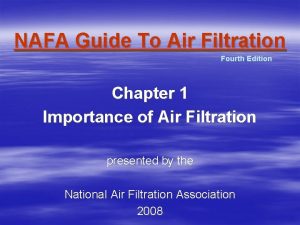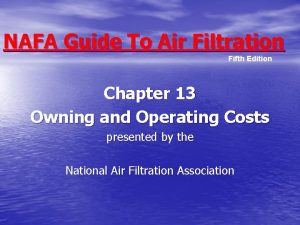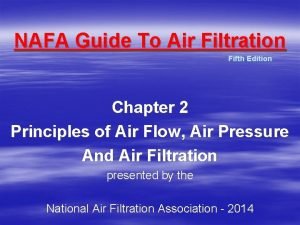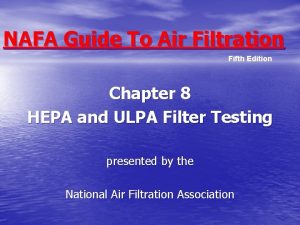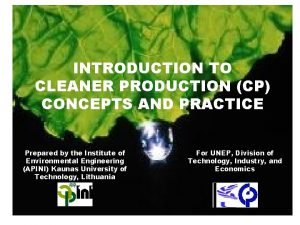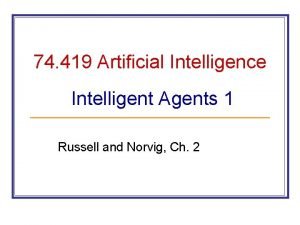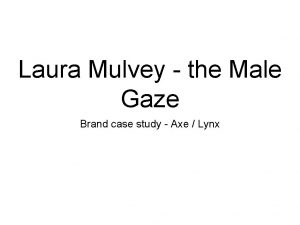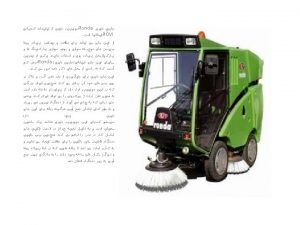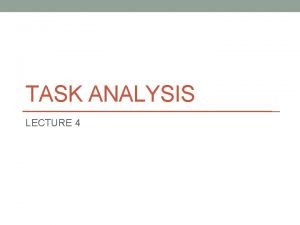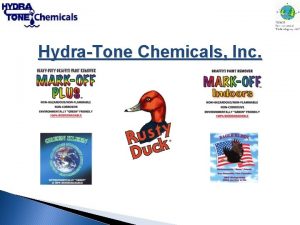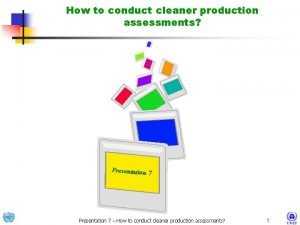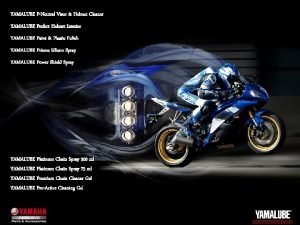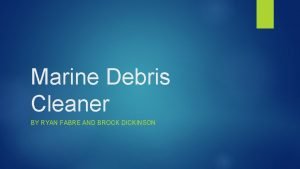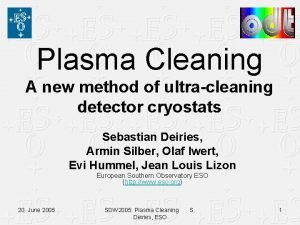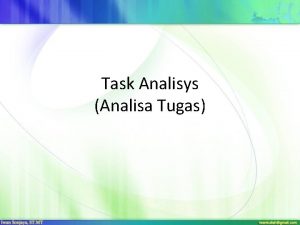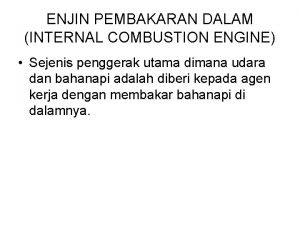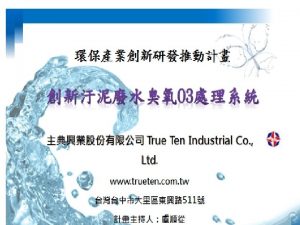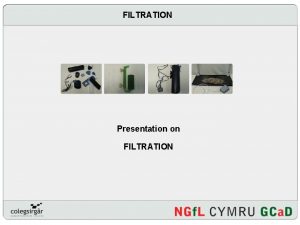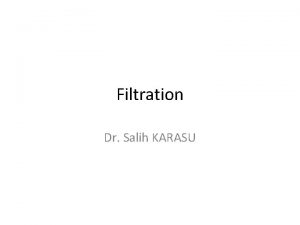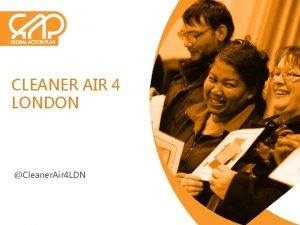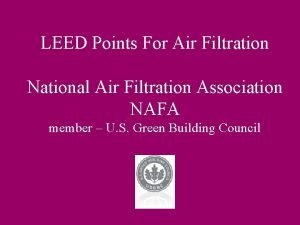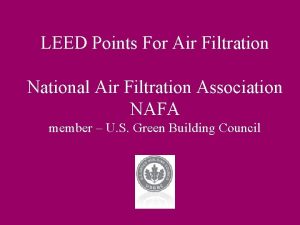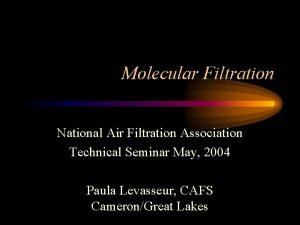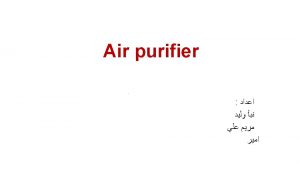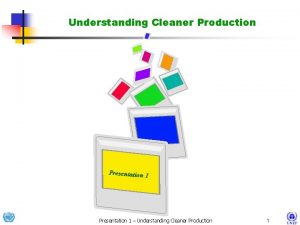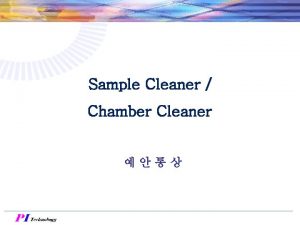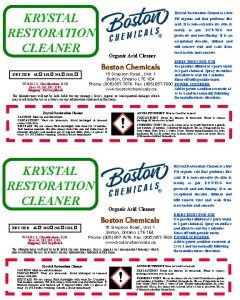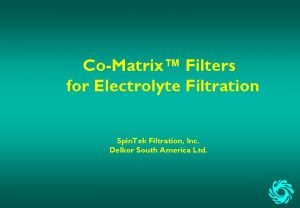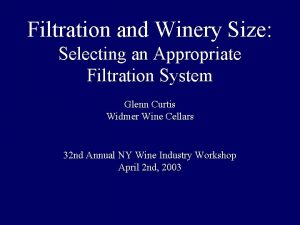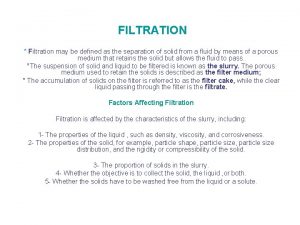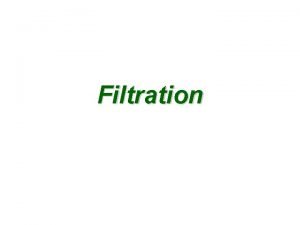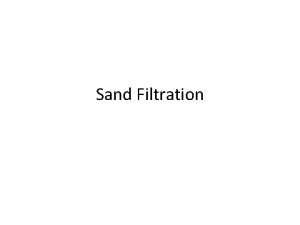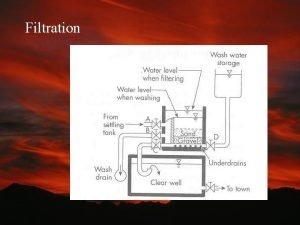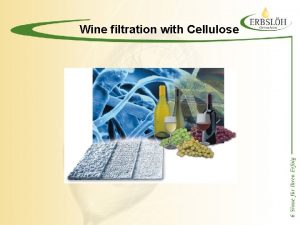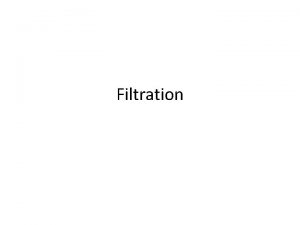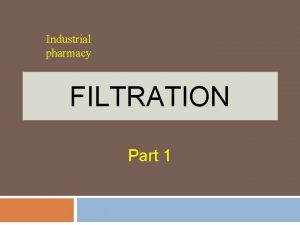Residential Air Filtration 1 Residential Issues l Cleaner
































- Slides: 32

Residential Air Filtration 1

Residential Issues l Cleaner Air – Removal of Particulates – Removal of Odors l Maintain Airflow l Customers Change Filters 2

Principles of Air Filtration Particulate Phase l Straining l Impingement (Inertial Impaction) l Interception l Diffusion l Electrostatic Attraction l Electrostatic Precipitation 3

Straining Airflow Particle Airstream Fiber Very large particles are captured between two fibers. Airflow 4

Impingement Airflow Fiber Particle Airstream Airflow Larger particles do not move around the fiber with the airstream and are carried into the fiber due to their momentum. 5

Spun Fiberglass Filters Picture provided by Glasfloss Industries, Inc. 6

Interception Airflow Fiber Airstream Particle Airflow Midsize particles move along with airstream lines and contact a fiber when they are just close enough. 7

Electrostatic Attraction Airflow Fiber Particle Airstream Airflow Particles are pulled to the fiber due to electrostatic attraction (charge) of the fiber that is opposite of the particle charge. 8

Electrostatic Attraction Airflow Fiber Particle Airstream Airflow Particles are pulled to the fiber due to electrostatic attraction (charge) of the fiber that is opposite of the particle charge. 9

Electrostatic Precipitation Electronic Air Cleaner www. fedders. com Particles past through an ionizing section and receive a strong positive charge. These particles are then collected on charged plates. Connected to 10 a

Residential Air Filter Standard ASHRAE 62. 2 “…has three primary sets of requirements…whole-house ventilation, local exhaust and source control. . ” 11

Residential Air Filter Standard l Ventilation - – Minimum Filtration – “MERV 6 or better. . ” MERV = Minimum Efficiency Reporting Value from ASHRAE 52. 2 -1999 12

Residential Air Filter Standard Definition: Acceptable indoor air quality – “air towards which a substantial majority of occupants express no dissatisfaction with respect to odor and sensory irritation and in which there are not likely to be contaminants at concentrations that are known to pose a health risk. ” 13

ASHRAE 52. 2 l A design qualification test l A destructive test to measure minimum efficiency reporting value (MERV) l Efficiency test aerosol is Potassium Chloride (KCl) particles, 0. 3 to 10 micron l Dust loading aerosol is ASHRAE Standard Test Dust

ASHRAE 52. 2 l Initial Resistance l l Pressure required to move air through filter at a certain air flow written in inches water, Pascal or millimeters water Final Resistance l Pressure at which the filter would be considered fully loaded

ASHRAE 52. 2 Test Duct Configuration Outlet Filters Exhaust ASME Nozzle Downstream Mixer Room Air Inlet Filters Blower Flow Control Valve Aerosol Generator Upstream Mixer OPC Device Section Backup Filter Holder (Used When Dust loading)

Typical 52. 2 Complete Loading Test Data Report Size Range (micron) Fractional Efficiency (%) at Resistance (in H 20) Composite Minimum Average 0. 28 0. 32 0. 46 0. 64 0. 82 1. 00 0. 3 to 0. 4 2. 7 6. 7 17. 2 29. 4 37. 1 37. 9 2. 7 0. 4 to 0. 55 7. 8 15. 9 27. 7 43. 3 53. 2 54. 6 7. 8 0. 55 to 0. 7 11. 2 30. 2 46. 0 60. 7 70. 5 71. 6 11. 2 0. 7 to 1. 0 17. 6 42. 6 59. 3 73. 7 81. 3 81. 8 17. 6 1. 0 to 1. 3 20. 4 51. 6 70. 3 80. 8 83. 7 85. 2 20. 4 1. 3 to 1. 6 23. 9 58. 2 76. 5 84. 7 86. 1 87. 2 23. 9 1. 6 to 2. 2 28. 3 69. 6 84. 1 89. 1 90. 2 91. 0 28. 3 2. 2 to 3. 0 36. 3 83. 9 91. 9 94. 2 94. 4 93. 2 36. 3 3. 0 to 4. 0 39. 4 89. 4 93. 7 95. 8 96. 4 94. 9 39. 4 4. 0 to 5. 5 42. 8 90. 6 95. 3 96. 5 97. 9 95. 6 42. 8 5. 5 to 7. 0 46. 5 92. 3 97. 1 98. 0 98. 4 97. 9 46. 5 7. 0 to 10. 0 50. 4 94. 8 97. 5 98. 3 100 99. 2 50. 4 E 1 = 9. 8 E 2 = 27. 2 E 3 = 44. 8 Minimum Efficiency Reporting Value is 6 at 492 fpm 17

Composite Minimum Curve 18

Table 7. 2. 1 Minimum Efficiency Reporting Value Composite Average Particle Size Efficiency (%) 0. 3 to 1. 0 E 1 1. 0 to 3. 0 E 2 3. 0 to 10 E 3 1 n/a E 3 < 20 2 n/a 3 n/a 4 Average Arrestance by ASHRAE 52. 1 Minimum Final Resistance Pa In Water Aavg < 65 75 0. 3 E 3 < 20 65 ≤ Aavg < 70 75 0. 3 n/a E 3 < 20 70 ≤ Aavg < 75 75 0. 3 n/a E 3 < 20 75 ≤ Aavg 75 0. 3 5 n/a 20 ≤ E 3 < 35 n/a 150 0. 6 6 n/a 35 ≤ E 3 < 50 n/a 150 0. 6 7 n/a 50 ≤ E 3 < 70 n/a 150 0. 6 8 n/a 70 ≤ E 3 < 85 n/a 150 0. 6 9 n/a E 2 < 50 E 3 ≥ 85 n/a 250 1. 0 10 n/a 50 ≤ E 2 < 65 E 3 ≥ 85 n/a 250 1. 0 11 n/a 65 ≤ E 2 < 80 E 3 ≥ 85 n/a 250 1. 0 12 n/a E 2 ≥ 80 E 3 ≥ 90 n/a 250 1. 0 13 E 1 < 75 E 2 ≥ 90 E 3 ≥ 90 n/a 350 1. 4 14 75 ≤ E 1 < 85 E 2 ≥ 90 E 3 ≥ 90 n/a 350 1. 4 15 85 ≤ E 1 < 95 E 2 ≥ 90 E 3 ≥ 90 n/a 350 1. 4 16 E 1 ≥ 95 E 2 ≥ 90 E 3 ≥ 90 n/a 350 1. 4 19

Table 7. 2. 1 Minimum Efficiency Reporting Value Composite Average Particle Size Efficiency (%) 0. 3 to 1. 0 E 1 1. 0 to 3. 0 E 2 3. 0 to 10 E 3 1 n/a E 3 < 20 2 n/a 3 n/a 4 Average Arrestance by ASHRAE 52. 1 Minimum Final Resistance Pa In Water Aavg < 65 75 0. 3 E 3 < 20 65 ≤ Aavg < 70 75 0. 3 n/a E 3 < 20 70 ≤ Aavg < 75 75 0. 3 n/a E 3 < 20 75 ≤ Aavg 75 0. 3 5 n/a 20 ≤ E 3 < 35 n/a 150 0. 6 6 n/a 35 ≤ E 3 < 50 n/a 150 0. 6 7 n/a 50 ≤ E 3 < 70 n/a 150 0. 6 8 n/a 70 ≤ E 3 < 85 n/a 9 n/a E 2 < 50 E 3 ≥ 85 n/a 10 n/a 50 ≤ E 2 < 65 E 3 ≥ 85 n/a 11 n/a 65 ≤ E 2 < 80 E 3 ≥ 85 n/a 12 n/a E 2 ≥ 80 E 3 ≥ 90 n/a 13 E 1 < 75 E 2 ≥ 90 E 3 ≥ 90 n/a 14 75 ≤ E 1 < 85 E 2 ≥ 90 E 3 ≥ 90 n/a 15 85 ≤ E 1 < 95 E 2 ≥ 90 E 3 ≥ 90 n/a 350 1. 4 16 E 1 ≥ 95 E 2 ≥ 90 E 3 ≥ 90 n/a 350 1. 4 20 E 1 = 9. 8% 150 250 E 2 = 27. 2% 250 E 3 = 44. 8% 250 350 MERV 350 6 0. 6 1. 0 1. 4

MERV l MERV then is an efficiency number for particle removal… l Gas-phase removal numbers are not mentioned in the standard… 21

Gaseous Contaminant Removal Principle Methods l Physical – Adsorption – Activated carbons l Chemical - Chemisorption – Chemically treated activated carbons – Potassium permanganate impregnated media 22

Principle Methods l Adsorption - The process by which one substance is attracted and held onto the surface of another. – It is a surface phenomena. – Capacity is independent of particle size – Adsorption rate is inversely proportional to particle size. 23

Principle Methods l Chemisorption - The result of chemical reactions on and in the surface of the adsorbent. – Fairly specific and depends upon chemical nature of media and the contaminant – Irreversible and essentially instantaneous 24

Gas Phase Contaminants l Where in the home? – Bathroom – Kitchen - biggest – Laundry room – Garage – Trash storage area – Pet area – Smoking household 25

Pressure–Velocity In the attempt to increase residential air filtration efficiency, little attention has been paid to the problem associated with increase pressure drop l Lower flow rates l Premature equipment failure l Bypass leakage in ductwork 26

Project: Test Pressure Drop with 3 Types of Residential Filters l Test Facility – one story 1800 sq. ft. condominium l Unit – 3 yr. old constant speed gas/ac unit l Motor – 1/3 hp with max. 0. 5” w. g. external static l Filter Grille and extended surface filter installation 27

Test Protocol l Fan turned to the “On” position l All filters removed l Readings taken with calibrated flowhood on return air grille No filter installed: 0. 30” w. g. 848 cfm 28

Filters Used Filter #1 – 1” standard fiberglass throwaway Filter 1 0. 35” w. g. 842 cfm 29

Filters Used l Filter #2 - 1” mini-pleated extended surface filter Filter 2 0. 50” w. g. 798 cfm 30

Filters Used l Filter #3 - 5” Extended surface unitmounted filter Filter 3 0. 40” w. g. 811 cfm 31

Summary Filter #1 – 1% decrease in flow 848 to 842 – 0. 35 ΔP Filter #2 – 6% decrease in flow 848 to 798 - 0. 5 ΔP – starts out clean at max. ext. static Filter # 3 – 4% decrease in flow 848 to 811 – 0. 4 ΔP 32
 Specific cake resistance definition
Specific cake resistance definition Charging toward cleaner air in london
Charging toward cleaner air in london Hubungan air tanah dan tanaman
Hubungan air tanah dan tanaman Nafa guide to air filtration
Nafa guide to air filtration Nafa guide to air filtration
Nafa guide to air filtration Nafa guide to air filtration
Nafa guide to air filtration National air filter
National air filter National air filtration association
National air filtration association Impingement filtration
Impingement filtration Nafa guide to air filtration
Nafa guide to air filtration Nafa filtration
Nafa filtration Nafa guide to air filtration pdf
Nafa guide to air filtration pdf Nafa guide to air filtration
Nafa guide to air filtration Cleaner production principles
Cleaner production principles Simple reflex agent vacuum cleaner
Simple reflex agent vacuum cleaner Laura mulvey male gaze article
Laura mulvey male gaze article The chaser short story
The chaser short story Piktou
Piktou Administrativia
Administrativia Fueled by marcie hans analysis
Fueled by marcie hans analysis Thieves cleaner packets
Thieves cleaner packets Moray eel and cleaner shrimp symbiotic relationship
Moray eel and cleaner shrimp symbiotic relationship Rusty duck gun cleaner
Rusty duck gun cleaner Conduct
Conduct Yamalube visor and helmet cleaner
Yamalube visor and helmet cleaner Kinetic letters jumper family
Kinetic letters jumper family Marine fabre
Marine fabre Green coil cleaner
Green coil cleaner Diener plasma cleaner
Diener plasma cleaner Floppy disk cleaner
Floppy disk cleaner Contoh task analysis
Contoh task analysis Keburukan injector cleaner
Keburukan injector cleaner Alkaline coil cleaner
Alkaline coil cleaner



